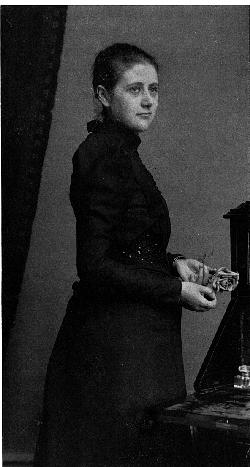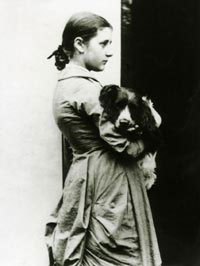<Back to Index>
- Philosopher Karl Raimund Popper, 1902
- Author Helen Beatrix Potter, 1866
- President of Peru Alberto Ken'ya Fujimori Fujimori, 1938


Helen Beatrix Potter (28 July 1866 – 22 December 1943) was an English author, illustrator, mycologist and conservationist best known for children's books featuring anthropomorphic characters such as in The Tale of Peter Rabbit.
Born into a privileged household, Potter was educated by governesses and grew up isolated from other children. She had numerous pets but as well because of holidays spent in Scotland and the Lake District,
developed a love of landscape, flora and fauna, all of which she
closely observed and painted. Her parents discouraged her intellectual
development as a young woman, but her study and watercolors of fungi led to her being widely respected in the field of mycology. In her thirties, Potter published the highly successful children's book, The Tale of Peter Rabbit. Around that time she became secretly engaged to her publisher Norman Warne.
This caused a breach with her parents, who disapproved of her marrying
someone of lower social status. Warne died before the wedding could
take place. Potter
began writing and illustrating children's books full time. With
proceeds from the books, she became financially independent of her
parents and was eventually able to buy Hill Top Farm in
the Lake District. She extended the property with other purchases over
time. In her forties, she married William Heelis, a local solicitor,
became a sheep breeder and farmer while continuing to write and
illustrate books for children. She published twenty-three books. Potter
died on 22 December 1943, and left almost all of her property to
the National Trust.
Her books continue to sell well throughout the world, in multiple
languages. Her stories have been retold in various formats including ballet, films, and in animation. Beatrix Potter was born in South Kensington,
London on 28 July, 1866. Educated at home by a succession of
governesses, she had little opportunity to mix with other children.
Even her younger brother, Bertram, was rarely at home; he was sent as a
boy to boarding school, leaving Beatrix alone with her many pets. She
had frogs, newts, ferrets and even a pet bat. She also had two rabbits
— the first was Benjamin, whom she described as "an impudent, cheeky
little thing", while the second was Peter, whom she took everywhere
with her on a little lead, even on the occasional outing. Potter
watched the animals for hours on end, sketching them and developing her
abilities as an artist. Beatrix Potter's father was Rupert William Potter (1832–1914), son of Edmund Potter. Rupert trained as a barrister, but spent his days at gentlemen's clubs and
rarely practised law. Her mother, Helen Potter née Leech
(1839–1932), the daughter of a cotton merchant, spent her time visiting
or receiving visitors. The family was supported by both parents'
inherited incomes. Every summer, Rupert Potter would rent a country house; Dalguise House in Perthshire, Scotland for the eleven summers of 1871 to 1881, then later, Lindeth Howe in the English Lake District where Potter illustrated The Tale of Timmy Tiptoes and The Tale of Pigling Bland. In 1882, the family met the local vicar, Canon Hardwicke Rawnsley, who was deeply worried about the effects of industry and tourism on the Lake District. He would later found the National Trust in
1895, to help protect the countryside. Potter had immediately fallen in
love with the rugged mountains and dark lakes. Through Rawnsley, she
learnt of the importance of trying to conserve the region, a
sensibility that was to stay with her for her entire life. When
Potter came of age, her parents appointed her as their housekeeper and
discouraged any intellectual development, instead requiring her to
supervise the household. From the age of 15 until she was past 30, she
recorded her everyday life in journals, using her own secret code which was not decoded until 20 years after her death. Her uncle attempted to introduce her as a student at the Royal Botanic Gardens at Kew, but she was rejected because she was a woman. Potter was later one of the first to suggest that lichens were a symbiotic relationship between fungi and algae. As,
at the time, the only way to record microscopic images was by painting
them, Potter made numerous drawings of lichens and fungi. As the result
of her observations, she was widely respected throughout England as an
expert mycologist. She also studied spore germination and life cycles of fungi. Potter's set of detailed watercolours of fungi, numbering some 270 completed by 1901, is in the Armitt Library, Ambleside. In 1897, her paper "On the Germination of Spores of Agaricineae" was presented to the Linnean Society by her uncle Sir Henry Enfield Roscoe,
as women were barred from attending meetings. (In 1997, the Society
issued a posthumous official apology to Potter for the way she had been
treated.) The Royal Society also refused to publish at least one of her technical papers. She also lectured at the London School of Economics several times. Potter had drawn, for her own enjoyment, illustrations for Joel Chandler Harris's Uncle Remus stories, and she was probably inspired by these as well as by the European tradition of animal fables going back to Aesop.
The basis of her many projects and stories were the small animals which
she smuggled into the house or observed during family holidays in
Scotland and the Lake District.
When she was 27 and on one such holiday in Scotland, in a letter dated
4 September 1893 she sent a picture and story letter about rabbits to
Noel Moore, the five-year-old son of her last governess, Annie (Carter)
Moore. Moore was the first to recognize the literary and commercial
value of Potter's picture and story letter and encouraged her to
publish the story. She borrowed back the letter in 1901, developed and expanded the tale, and made it into the book titled The Tale of Peter Rabbit and Mr. McGregor's Garden. She
sent her slightly rewritten picture letters to six publishers, but was
turned down by all of them. The primary complaint from all of them was
the lack of colour pictures, which were popular at the time. In
September 1901, she decided to self-publish and distribute 250 copies
of a renamed The Tale of Peter Rabbit.
Later that year, because the colour printing blocks were already
created and other children’s books were popular, she finally attracted
the publisher Frederick Warne & Co. The publishing contract was signed in June 1902 and, by the end of the year, 28,000 copies were in print. Later, the character Peter Rabbit was patented and produced as a soft toy in 1903. This makes Peter the oldest licensed character. She followed Peter Rabbit with The Tale of Squirrel Nutkin in
1903, that was also based on an earlier letter to one of the Moore
children. Such was the popularity of these and her subsequent books
that she gained an independent income from their sales. She also became
secretly engaged to the publisher, Norman Warne in 1905, but her
parents were set against her marrying a tradesman. Their opposition to
the wedding caused a breach between Beatrix and her parents. The
wedding was not to be, for soon after the engagement, Norman fell ill of pernicious anemia and
died within a few weeks. Beatrix was devastated. She wrote in a letter
to his sister, Millie, "He did not live long, but he fulfilled a useful
happy life. I must try to make a fresh beginning next year." Potter
eventually wrote 23 books, all in the same small format. Part of the
popularity of her books was due to the quality of her illustrations:
the animal characters are portrayed as full of personality, but are
deeply based in natural actions. Her writing efforts finally abated
around 1920 due to poor eyesight. The Tale of Little Pig Robinson was
published in 1930; however, the actual manuscript was one of the first
to be written and much predates this publication date. After Warne's death, Potter purchased Hill Top Farm in the village of Sawrey (then in Lancashire, now in Cumbria), in the Lake District. She loved the landscape, and visited the farm as often as she could, discussing the set-up with farm manager John Cannon. With the steady stream of royalties from her books, she began to buy pieces of land under the guidance of local solicitor William
Heelis. In 1913 at the age of 47, Potter married Heelis and moved to
Hill Top Farm permanently. Some of Potter's best-loved works show the
Hill Top farmhouse and the village. While the couple had no children,
the farm was constantly alive with dogs, cats and even a pet hedgehog
named "Mrs. Tiggy-Winkle". On moving to the Lake District, Potter became engrossed in breeding and showing Herdwick sheep. She
became a respected farmer, a judge at local agricultural shows, and
President of the Herdwick Sheep Breeders' Association. When Potter's
parents died, she used her inheritance to buy more farms and tracts of
land. After some years, Potter and Heelis moved down into the village
of Sawrey, and into Castle Cottage — where the local children knew her
for her grumpy demeanour, and called her "Auld Mother Heelis". Her letters of the time reflect her increasing concerns with her sheep, preservation of farmland, and World War II. Beatrix Potter died at Castle Cottage in Sawrey on 22 December 1943. Her body was cremated at Carleton Crematorium, Blackpool and her ashes were scattered in the countryside near Sawrey. In her will, Potter left almost all of her property to the National Trust — 4,000 acres (16 km²) of land, cottages, and 15 farms. The legacy has helped ensure that the Lake District and the practice of fell farming remain unspoiled to this day. Her properties now lie within the Lake District National Park. The Trust's 2005 Swindon headquarters are named "Heelis" in her honour. Her literary estate is owned by Chorion, a media rights company that specialises in classic British children's characters. Beatrix Potter Gallery, a gallery run by the National Trust and situated in a 17th-century Lake District townhouse in Hawkshead, Cumbria, England, now displays her original book illustrations.